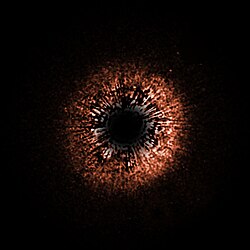HD 107146
| Observation data Epoch J2000.0[1] Equinox J2000.0[1] | |
|---|---|
| Constellation | Coma Berenices[2] |
| Right ascension | 12h 19m 06.5015s[1] |
| Declination | 16° 32′ 53.869″[1] |
| Apparent magnitude (V) | 7.07[1] |
| Characteristics | |
| Spectral type | G2V[1] |
| Astrometry | |
| Radial velocity (Rv) | 6.2[1] km/s |
| Proper motion (μ) | RA: -175.65[1] mas/yr Dec.: -148.28[1] mas/yr |
| Parallax (π) | 35.07[1] ± 0.88[1] mas |
| Distance | 92.96[3] ly (28.5[3] pc) |
| Details | |
| Luminosity | 1.1[4] L☉ |
| Age | 80 - 200 myr[3] years |
| Other designations | |
NLTT 30317, GSC 01445-02267, PLX 2836, SAO 100038, AG+16 1260, HD 107146, PPM 128955, SKY# 23079, AGKR 11033, HIC 60074, RBS 1096, SPOCS 527, ASCC 867033, HIP 60074, 2RE J1219+163, TYC 1445-2267-1, BD+17 2462, IRAS 12165+1649, 2RE J121906+163301, UBV M 18049, BSD 80-883, IRAS F12165+1649, RE J121908+163239, UBV 11059, GC 16796, LSPM J1219+1632, RE J1219+163, USNO-B1.0 1065-00201409, GCRV 7378, LTT 13439, RX J1219.1+1632, uvby98 100107146, GEN# +1.00107146, 2MASS J12190650+1632541, 1RXS J121906.8+163259, YZ 16 4641[1] | |
HD 107146 is a G2V (yellow dwarf) star, located 88 light years from Earth.[3] In 2003, astronomers recognized the excess infrared[5] and submillimeter[3] emission indicative of circumstellar dust, the first time such a debris disk phenomenon was noted around a star of similar spectral types as the Sun, though having a much younger age. In 2004 the Hubble Space Telescope detected the presence of a spatially resolved disc surrounding the star[6][4] Observations have given the age of the star at between 80 and 200 Myr.[3]
Circumstellar disc
The star's circumstellar disc has dimensions of approximately 210 x 300 AU.[3] The dusty ring is cool, with a temperature of 51 K, and has a mass of 0.10 M⊕.[3] Analysis of the debris disk in the far-infrared and submillimeter wavelengths, carried out using the Hubble Space Telescope, suggests the presence of small grains in the disk.[4] The disk appears to be slightly elongated to form an ellipse with its minor axis at a position angle of 58° ± 5°; working under the assumption that the disk is in fact circular gives it an inclination of 25° ± 5° from the plane of the sky.[4] Recent analysis suggests the possible presence of a planet at 45-75 AU.[7]
References
- ^ a b c d e f g h i j k "SIMBAD Object query: HD 107146".
- ^ "Quick Facts: Spitzer and Hubble Capture Evolving Planetary Systems". Spitzer Science Center.
- ^ a b c d e f g h Williams, Jonathan P.; et al. (2004). "Detection of Cool Dust around the G2 V Star HD 107146". 604: 414–419.
{{cite journal}}: Cite journal requires|journal=(help); Explicit use of et al. in:|first=(help); Unknown parameter|jorunal=ignored (help); Unknown parameter|month=ignored (help) - ^ a b c d Ardila, D. R.; et al. (2004). "A Resolved Debris Disk Around the G2 V Star HD 107146" (PDF). The Astrophysical Journal. 617 (Part 2): L147–L150. doi:10.1086/427434.
{{cite journal}}: Explicit use of et al. in:|first=(help) - ^ Metchev, Stanimir; et al. (2004). "Ten Micron Observations of Nearby Young Stars" (abstract). The Astrophysical Journal. 600: 435–450. doi:10.1086/379788.
{{cite journal}}: Explicit use of et al. in:|first=(help); Unknown parameter|month=ignored (help) - ^ "Spitzer and Hubble Capture Evolving Planetary Systems". hubblesite.org. December 9, 2004.
- ^ Template:Url = http://arxiv.org/abs/0811.2713

